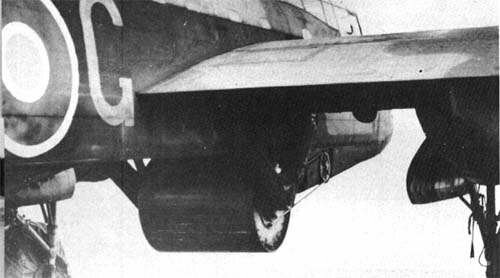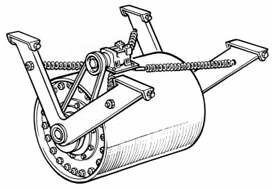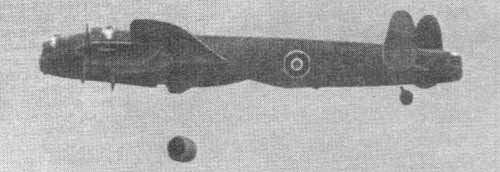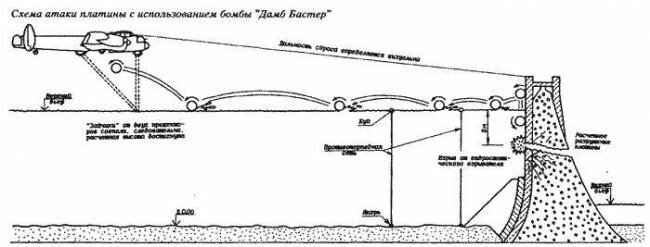Jumping bomb

The idea of a bomb jumping over water, like a pebble, came up with the English engineer and aircraft designer Sir Barnes Wallis during the Second World War, in 1942-1943. To crush the military power of Germany, the Allies needed to destroy its heavy industry, which worked mainly for the army. The main armory The Nazi workshop was the Ruhr Industrial District. Military plants were supplied with water and electricity from several reservoirs. And if their dams are destroyed, the plants will stand up, because, for example, to produce tons of steel it is necessary to spend seven tons of water. In addition, floods caused by the breakthrough of dams will flood settlements downstream, wash out roads and bridges, damage communication lines and cause significant damage to agriculture.
The dams were earthen mounds reinforced with concrete and more than 10 meters thick. To destroy such a structure, it is necessary to expend 30 tons of explosives. No bomber of that time could not lift a bomb of such weight. However, the calculations showed that if the charge is placed from the pressure side of the dam at a certain depth, its value can be reduced to 5 tons (a shock wave in the water will increase the effect of the explosion several times). But how to deliver the charge to the right place? Ordinary bombs were not suitable because of the low accuracy of bombing, and dams are well protected from torpedoes by anti-torpedo networks.


It was here that Wallis came up with: it was necessary to force the bomb to get to the desired point of the dam on the surface of the water under its own power, that is, at the expense of a ricochet. Perhaps this idea occurred to him during the launching of "pancakes" - they say he often amused himself with this with his grandchildren. Whether he studied the phenomenon of "pancakes" from a scientific point of view, we do not know - his work is still kept secret by the British military department. The Wallis project consisted of the following: to hang a cylindrical bomb under the plane across the fuselage, unwind the cylinder around its axis to a certain speed, and then drop the bomb from a low altitude at some distance from the target, so that the bomb independently “jumps” to it. Hitting the dam, the bomb had to roll down its wall under the water to the required depth, where the hydrostatic fuse would work. The rotation of the bomb provided it with stability after discharge due to the gyroscopic effect. The direction of rotation was chosen so that, firstly, to reduce the friction of the bomb on the water, and secondly, so that in the event of a bomb dropping onto the parapet of the dam, it would slide back to its pressure side.
At first, the Wallis project did not arouse enthusiasm among the British leadership, but after a series of experiments, the attitude towards it changed dramatically, and by the spring of 1943, the rotational bomb entered service with the 617 st squadron. It was a cylinder with a diameter of 124 centimeter, a length of about one and a half meters and a total weight of 4200 kilograms (explosives weighed about 3 tons). The cylinder spun up to about 500 revolutions per minute. The hit of two such bombs should have been enough to break the dam.
Preliminary calculations showed that the bomb must be dropped at a speed of 345 km / h from a height of 18,5 meters at a distance of 390 meters to the target. Complying with such harsh conditions seemed almost impossible. Conventional means - barometric or radio altimeters, as well as bomb sights - were unsuitable: the flight altitude was too low. However, the solution was still found, with a simple and witty. To control the height of the aircraft installed two searchlights. The first searchlight, mounted on the nose of the aircraft, shone vertically downwards, the second, on its tail, at an angle to the vertical. Rays of searchlights intersected at a distance 18,5 meter. The pilot had to lead the aircraft so that the spots from the spotlights on the surface of the water merged. The distance to the dam was determined using the simplest range finder, and two towers located on the dam crest just in the middle were used as a reference point (the distance between them was measured by aerial photographs). The range finder was a plywood triangle, in one of the peaks of which an eye was installed, and in the other two there were studs hammered in such a way that when looking through the eye of the turret and the studs coincided exactly in the place where the bomb had to be dropped.
The attack was carried out at night 16 May 1943. As a result of the bombing, two large dams were broken through, two more were seriously damaged. As a result of the devastation of reservoirs and devastating floods, industrial production in the Ruhr fell by a third for several months, normalized water consumption was introduced. The German economy suffered serious damage, which affected the results of the Wehrmacht hostilities. True, the British’s losses during the bombing were enormous: 19 did not return from the 9 aircraft, and 133 pilots died from the 56 crew. But in general, the operation was recognized successful.
A jumping bomb was created to solve a specific problem - the destruction of dams, it was simply not suitable for anything else. That is why in literature it is most often called Dam Buster (dam destroyer). In addition, Wallis actually created a “disposable” weapon, the re-use of which was very problematic: knowing about the threat, the enemy could reduce its effectiveness to zero by simple measures (for example, put barrage balloons or add anti-aircraft machine guns). Nevertheless, the destruction of dams with bombs entered into history as one of the most original and witty operations conducted by the British army during the Second World War.

Information